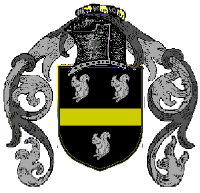| |

|
 |
|
 1274 - 1329 (54 years) 1274 - 1329 (54 years)
-
| Name |
Scotland, Robert I "The Bruce" King of |
| Title |
"de BRUS" |
| Born |
11 Jul 1274 |
Writtle, Near Chelmsford, Essex, England  [1] [1] |
| Gender |
Male |
| Died |
7 Jun 1329 |
Cardross, Dunbartonshire, Scotland  |
| Buried |
Abbey Church, Dunfermline, Fifeshire, Scotland  [1] [1] |
| Person ID |
I4236 |
My Genealogy |
| Last Modified |
21 Jan 2022 |
| Father |
De Brus, EARL OF CARRICK Robert, b. Jul 1243, Of, Annandale, Dumfrieshire, Scotland  , d. Bef 4 Apr 1304, Palestine , d. Bef 4 Apr 1304, Palestine  (Age < 60 years) (Age < 60 years) |
| Relationship |
natural |
| Mother |
Carrick, Margaret Countess of, b. Abt 1252, Of, Carrick, Ayrshire, Scotland  , d. Bef 27 Oct 1292 (Age < 40 years) , d. Bef 27 Oct 1292 (Age < 40 years) |
| Relationship |
natural |
| Married |
1271 |
Turnberry Castle, Ayrshire, Scotland  [1] [1] |
| Family ID |
F2304 |
Group Sheet | Family Chart |
-
| Event Map |
|
 | Born - 11 Jul 1274 - Writtle, Near Chelmsford, Essex, England |
 |
 | Married - 1302 - Writtle, Near Chelsford, Essex, England |
 |
 | Died - 7 Jun 1329 - Cardross, Dunbartonshire, Scotland |
 |
 | Buried - - Abbey Church, Dunfermline, Fifeshire, Scotland |
 |
 | Married - - Of, Northumberland, England |
 |
|
-
| Notes |
Biographical Text:
Robert the Bruce, 2nd Earl of Carrick and grandson of the old Competitor had supported Edward I against Balliol but, when Wallace renounced the guardianship of Scotland Bruce and Balliol's nephew,John "Red" Comyn replaced him as joint guardians. After a quarrel with Comyn he returned to Edward's camp and obtained a pardon. Bruce, seeking a reconciliation with Comyn, impulsively stabbed him at Dumfries in a church. He was again outlawed by Edward and excommunicated. Bruce claimed the Scottish throne as great-great-grandson of David I and was crowned at Scone in 1306. He went into hiding in a cave on an island off Ireland after he killed Red Comyn. This is where we get the legend of Bruce and the spider. We do not know if this is a true story but it makes a good legend. He watched the spider spinning its web and attempting to fix the web to the ceiling. At last the spider succeeded. According to the legend, this inspired Bruce to overcome his many hardships and persevere until he had won back Scotland. He made plans to take back his original home, Turnberry Castle. As they made their way to the castle, the plan was that if all was well, a light would be showing at the castle wall. They did see the light but upon nearing the castle, discovered that it was an enemy fire. Nonetheless, Bruce attacked and by this surprise attack gained food, armour and horses. He learned that three of his brothers and his wife, daughter and two sisters had been imprisoned by the English. Although he was now King, he was not well supported by the nobles and so Scottish lands and castles remained in the hands of the English. He knew that he would have to fight castle by castle in order to regain Scotland and drive the English out. Through his perseverance, by 1324 all castles in Scotland except Stirling were in Scottish hands. By this time Edward II was on the throne of England and was much more ineffectual than his father.
Bruce's much smaller force spectacularly defeated Edward II's 20,000 strong army at Bannockburn. I will say no more here about the Battle as it has been so well written by Skye.
The Declaration of Arbroath, an affirmation of Scottish independence, was sent to the Pope but the Pope did not recognize Bruce for four years as the rightful king of Scotland. After Edward III ascended to the throne, Bruce's army harassed the English so much that Edward III was forced to acknowledge his sovereignty and Scotland's freedom.
Not long after the peace Bruce died. He was buried in Dunfermline Abbey. He had always wanted to go on a crusade. When he died his heart was placed in a silver casket and kept by Sir James Douglas who planned to take it on a crusade to the Holy Lands. Douglas joined the army of the King of Spain and while fighting a battle was killed. But before he died, he threw the casket in the midst of the battle crying, "Now go before, brave heart, as you always did, and I shall follow you or die." The casket was recovered
and returned to Scotland.
At the end of Bruce's life, he had achieved what he had fought for years to accomplish. Scotland was once again an independent kingdom. Scotland remembers him as "Good King Robert" and his triumph at Bannockburn is a rallying cry to Scots everywhere. Scotland would never again be conquered. Bruce's final legacy was to confirm "Scotland as separate and distinct, not just as a kingdom but as a community, a people and ultimately a nation."
|
-
| Sources |
- [S27] Ancestral File (TM), The Church of Jesus Christ of Latter-day Saints.
Date of Import: Apr 18, 2000
|
|
|
|